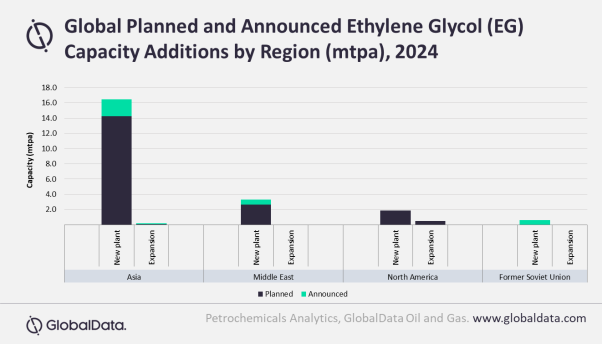Sep 14 2020
Global ethylene glycol (EG) capacity is poised to see considerable growth over the next five years, potentially increasing from 41.80 million tonnes per annum (mtpa) in 2019 to 65.04 mtpa in 2024, registering a total growth of 56%.

Among the regions, Asia leads the capacity additions and the region’s ethylene glycol capacity is expected to increase from 23.10 mtpa in 2019 to 40.08 mtpa in 2024, at an average annual growth rate (AAGR) of 11%, says GlobalData, a leading data and analytics company.
The company’s report, ‘Global Ethylene Glycol (EG) Industry Outlook to 2024 – Capacity and Capital Expenditure Forecasts with Details of All Active and Planned Plants’ reveals that Asia is expected to have a new-build and expansion ethylene glycol capacity of 16.64 mtpa from 32 new-build and expansion projects. Out of these, 29 are new-build projects and the remaining are expansion projects.
Dayanand Kharade, Oil and Gas Analyst at GlobalData, says: “In Asia, the capacity growth of EG will be mainly from China, which accounts for around 73% of the regions’ capacity additions. New-build projects account for most of these capacity additions in China.”
GlobalData identifies India as the second highest country within the region in terms of capacity additions, with capacity increase from 2.22 mtpa in 2019 to 5.07 mtpa in 2024, at an AAGR of 16.6%. Major capacity additions will be from the plant, Haldia Petrochemicals Kakinada Ethylene Glycol Plant, with a capacity of 0.75 mtpa by 2024.
Indonesia will be the third highest country within the region in terms of capacity additions, with capacity increase from 0.22 mtpa in 2019 to 0.92 mtpa in 2024, at an AAGR of 28.9%. Major capacity additions will be from the plant, Lotte Chemical Corporation Cilegon Ethylene Glycol Plant, with a capacity of 0.70 mtpa by 2023.
Zhejiang Satellite Petrochemical Co Ltd, China Sanjiang Fine Chemicals Co Ltd and Tangshan Xuyang Petrochemical Co Ltd will be the top three companies in Asia in terms of planned and announced capacity additions over the outlook period.